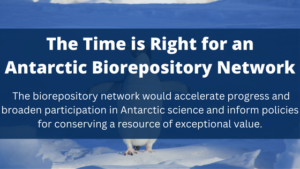A major impediment to scientific progress in Antarctica is access. Its extreme weather, remoteness, and inaccessibility to some regions make the logistics of conducting Antarctic research extraordinarily challenging and expensive. Yet across the world, museums and universities possess an extensive, largely untapped wealth of Antarctic specimens, including dried and frozen samples, and DNA extracts.

In the United States, many Antarctic collections are held by principal investigators (PIs) funded by the National Science Foundation, who are largely unaware of data standards (e.g., Darwin Core Standard—a community-developed and evolving set of data standards established to maximize sharing, use, and reuse of biodiversity data) and protocols for specimen management (e.g., the International Society for Biological and Environmental Repositories Best Practices guidelines for managing specimens). They also lack the resources to properly curate their collections. As a result, the majority of Antarctic biological specimens are invisible and inaccessible to the broader scientific community. The time has come to establish a biorepository network of Antarctic specimens for addressing the most critical questions in Antarctic science, improving human welfare, and mitigating the impacts of climate change.
Click here to read more.